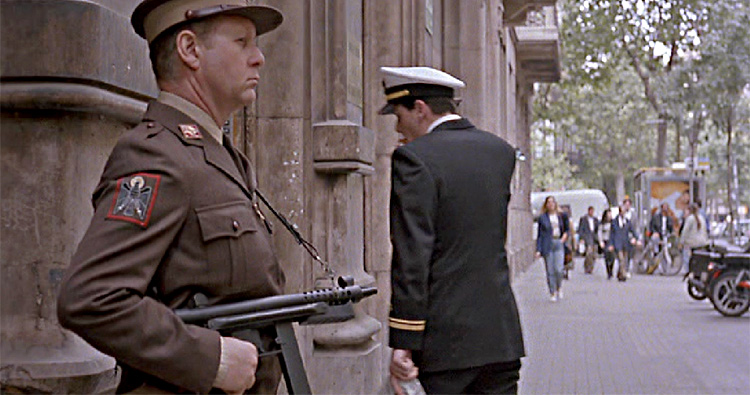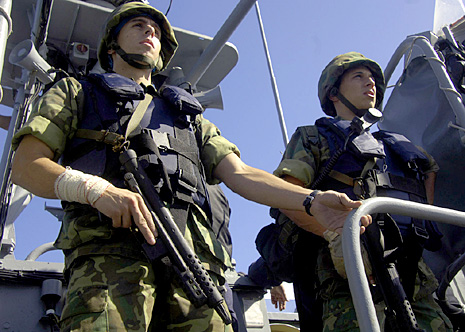Star Firearms — The Z-62, Z63, Z70 & Z-70/b sub-machine guns
Despite being known best in the commercial market for handguns, Star's primary business has been in many ways their military submachine guns. The fall of the SMG in the 1980s to the 5.56 mm carbine may even have been a contributing cause of their eventual demise.
From just before the Civil War, until the 1990s, one Star SMG model has replaced another in Spanish army service, as well numerous export countries. For more, read up on stocked- and machine-pistols or find your stocked SMG in the progression of Spanish service weapons:
Si35, RU35 & TN35 → Z-45 → Z-62 Series → Z-75 & Z-84
Z-62 Series
The replacement for the Z-45 was another basically second generation gun, with a simple tubular receiver operating an open-bolt, straight-blowback mechanism. But the Z62 series is an entirely new gun, using the best knowledge they had about manufacturing and ergonomics, to make whole weapon more compact, lighter, and easier to use.
Despite being very late for a new tubular receiver design, these improvements really worked, so muchh so it still in service with some units of the Spanish armed forces (last checked in 2016).
There are several guns in this series, which have some confusing similarities and differences. Remember this was made during what we call the Classic era for handguns. Remember how the Model A and B pistols are the exact same gun with different chamberings? Much the same occurs in tis SMG series:
- Z-62 – The original issued SMG in 9 mm Largo, replacing the Z-45 one for one in Spanish service.
- Z-63 – A prototype of the Z62 in 9 mm Luger/Parabellum to plan for the integration of Spain with NATO standards. Since assigned a series number, it may have been produced in small quantities, such as for a military trial, but I have no direct evidencce of tis.
- Z-70 – The production designation for the 9 mm Luger/Parabellum version of the Z62.
- Z-70/B – A general product improvement, with the same overall mechanical layout, but in an entirely redesigned fire control unit, magazine release, stock, and other changes.
It does not appear that Z-70 or Z-70/B were reworked earlier models, but it could simply be that the Star factory did such a complete job of the rework that there is no evidence such as overstamping.
Fire Control
The Z62, 63, and 70 achieve fire-selection through a somewhat unique two-finger "selecting trigger." Pulling the bottom notch rotates the trigger and fires the gun in fully-automatic mode; pulling the top notch slides the trigger to the rear and fires in semi-automatic mode. Rate of fire in fully-automatic mode is about 550 spm. This is apparently a Spanish Army requirement, as all subsequent Star models have the same rate of fire. The safety is a cross-button in the top, middle of the pistol grip.
The Z-70/B abandoned this and uses a conventional, single point rotating trigger. Fire selection is achieved via a rotating lever on the left side of the pistol grip, where it may be actuated with the firing thumb. This lever also incorporates a safety setting.
While a thumb-actuated fire safety/selector seems obvious now, in 1971 when it was made, this was almost cutting edge, with many service rifles still using other methods. Forget older guns, the space age FAMAS and AUG were years from service, and had – respectively – a separate safety / fire selector, and a crossbolt safety and two function trigger.
The thumb lever made lots of sense to make it all more similar to the CETME rifles otherwise used by the Spanish armed services, but was by no means in 1971 a foregone conclusion as the right way to design a gun.
Dual Trigger Series (Z-62, Z-63, Z-70)
NOTE: This is all in progress, and everything past this intro is to be treated with suspicion. All these guns are very similar, and will be reviewed in detail based most of all on the Royal Armories examples I was able to inspect.
Fire control
TBD
Sights
TBD
Buttstock
TBD
Charging Handle and Forearm
TBD
Bolt and Operating Mechanmism
TBD
Video on the Z63 https://www.youtube.com/watch?v=4ED2g8ZSoB8&t=17s Video on Z70 (and other stuff) https://www.youtube.com/watch?v=AFQ9RdMtcxALegacy Info follows...
Experienced gained from Spanish Army service with the Z-45 resulted in Star creating an improved, but still 2nd generation SMG in the late 1950s. This entered service in 1963, as the Z62 in 9 mm Largo. A model for commercial sales only in 9 mm Parabellum is known as the Z63. In Spanish Army service, Z62s largely supplanted Z45s one for one. It was replaced in service in the early 1970s by the mostly similar Z-70/B, below.
The Z-62 is much more compact than the Z-45, largely due to a different layout, where the pistol grip is much closer to the magazine well. The overall tube length, and bolt travel are approximately the same. The buttstock rotates about a point near the pistol grip, so overlaps the rear of the tube as well. An unloaded weapon weighs 2.65kg (5.84 lbs).
The weapon is made entirely of steel, except for plastic grip panels. Many components are machined, with stampings for the stock, tube, trigger assemblies and other exterior components only, all welded to themselves or to reinforcing frames to keep their shape. The barrel is 20 cm long (7.85") and it can fit 20, 30 or 40-round magazines. Magazines are ejected by pressing a button at the front of the trigger guard from right to left (as on the M-16). The rear sight is a flipover L type within protected wings, with aperatures marked for 100 and 200 m. The gun is zeroed so the 100 m aperature is also the "battle sight" so will hit within a few inches of the point of aim from 0 to 100 m.
These weapons all fire from the open bolt position, but do not have a fixed firing pin. I am unclear as to how exactly this operates.
If you are a real fan of Star SMGs, download this very large image of the muzzle of a Z62 which I have cut out, and stuck a Star logo on. Use it for your desktop, or just stare at it. Thanks to reader Jason Hutchins for the photography of his SMG.
All Star firearms marked 9 mm / 38 are designed to fire .38 ACP and 9 mm Largo ammunition, but NEVER .38 Super. Read more detail on ammunition for older firearms.

The Z-70 is still in use with second-line troops of all sorts, across Spain. It is especially commonly seen in use by the Navy, by shipboard protection forces, as those seen below. I will note that the finish of these guns seems to be perhaps the best ever made. 30-40 year old guns, expecially those in service aboard ships, should not be in such good condition. Spanish Marines have all upgraded to the Z-84, or use .223 carbines instead.

Z-70/B
NOTE: This is all in progress, and everything past this intro paragraph is to be treated with suspicion. The Z70/b is a product improved version, and the changes will be reviewed in detail, eventually.
Video on Z70/b https://www.youtube.com/watch?v=19DUiCsvsYEThe Z-70s are basically product improved versions of the Z-62/63 SMG. There are no serious changes to the overall function or method of construction and the guns are the same size and weight. The 40 round magazine was apparently discontinued for this weapon.
Z-70s are only made in 9 mm Parabellum. This marked Spain's alignment with NATO, and their general move from Largo to Parabellum across the forces. The other major change was to the trigger assembly. The Z-70s have a conventional, single point rotating trigger. Fire selection is achieved via a rotating lever on the left side of the pistol grip, where it may be actuated with the firing thumb. This lever also incorporates a safety setting. The magazine release has been changed to a lever type, below the trigger guard.
A number of other small changes in the overall design were also made. None of these affect general use, and are presumably either to improve performance, longevity or reduce manufacturing costs. These changes seem to indicate that most parts are not interchangable between the two series, despite their optward similarity. I believe that the Z-70 was the commercial and development model, and the Z-70/B incorporated some trivial changes for Army service, but I do not know what the difference between the two weapons is.
For an additional view of the Z70B, see the photo at the top of this page.
It is not clear the /B variants were adopted, or at least adopted in quantity, by the Spanish armed forces. I have seen much information about them, even in the popular Spanish arms press of the time, but no photos of Spanish soldiers, sailors or Marines carrying this version.
The Z-70 are still in use with second-line troops of all sorts, across Spain. It is especially commonly seen in use by the Navy, by shipboard protection forces, as those seen below. I will note that the finish of these guns seems to be perhaps the best ever made. 30-40 year old guns, expecially those in service aboard ships, should not be in such good condition. Spanish Marines have all upgraded to the Z-84, or use .223 carbines instead.

Manuals & Disassembly Instructions
I do not have manuals for every pistol shown on this site. However, in many cases there is a related manual. Partly to make the series relationships clearer, and partly to assist with speed and accuracy of updating, all manuals can be found in one place, the manuals page. All manuals available are provided as downloadable PDFs, or you may purchase a printed copy of the entire set of handgun manuals.
I have no manuals for this series of SMGs, but have taken one apart so so can provide some small hints for basic field stripping.


